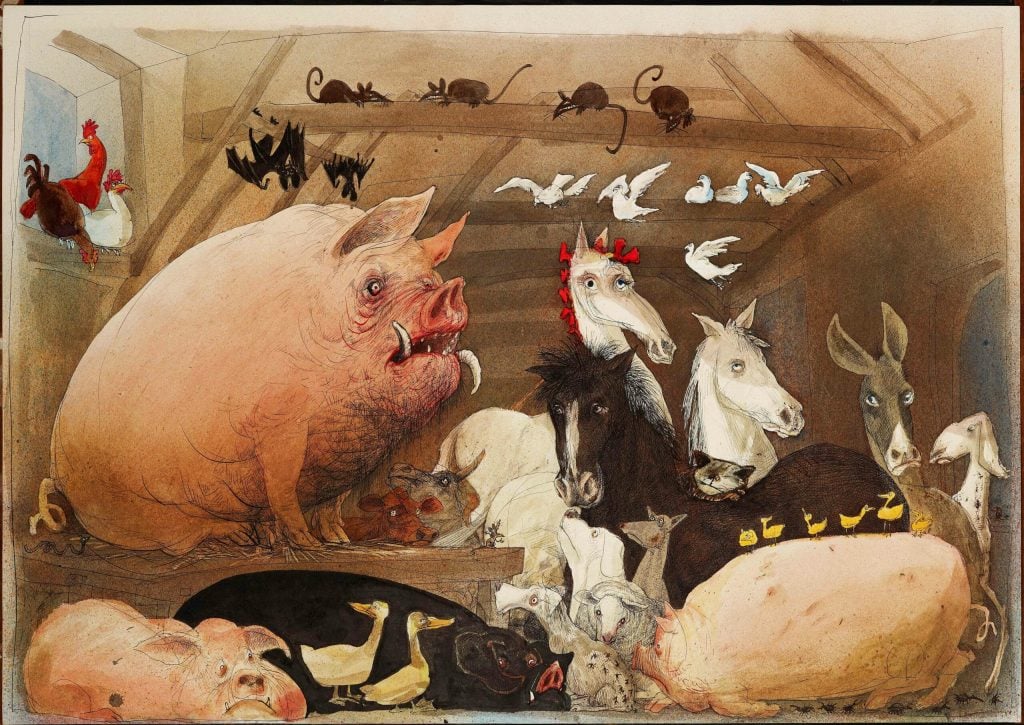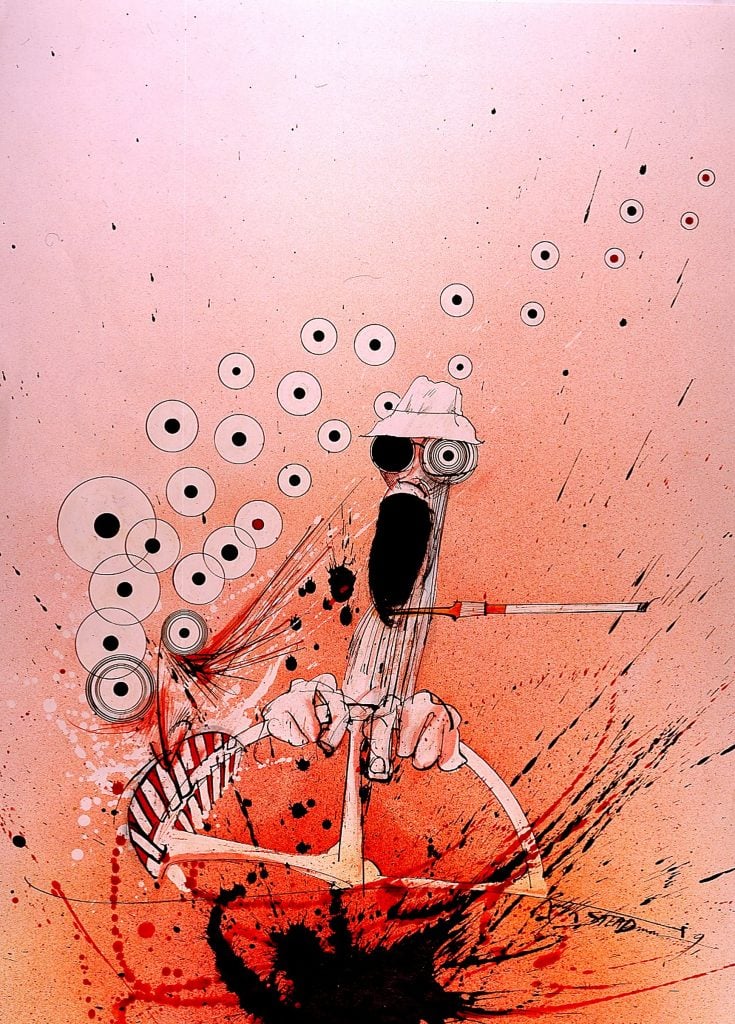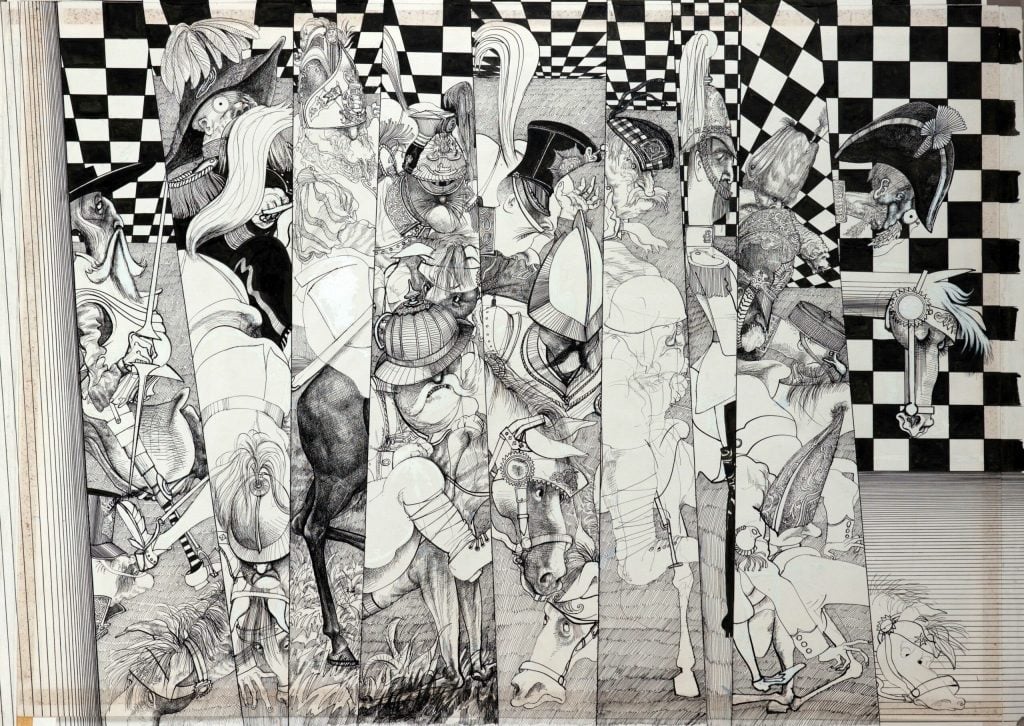Art & Exhibitions
‘Fear and Loathing’ Illustrator Ralph Steadman Kicks Off a Marathon Touring Retrospective
Book jackets, political cartoons, and early abstraction will be on show at various U.S. venues through 2027.

There’s a call atop Ralph Steadman’s X account to “Enter the Steadmanverse.” Click the link and you travel to a Discord server comprised of two dozen or so sleepy channels. It’s a holdover of Steadman’s flirtation with NFTs that came at a time when web3 was seemingly imminent and inevitable.
The move spoke of an octogenarian who remains curious, an artist whose instantly recognizable works of spidery lines and grotesque subjects have remained both relevant and in-demand. Case in point, Harley-Davidson and Supreme recently dropped apparel splashed with Steadman ink. But for enduring popularity, look no further than college campuses where Steadman’s status as the irreverent illustrator-in-chief of ‘70s counter-culture has made his work a dorm wall staple.
Fitting then, that U.S. universities are set to play host to a comprehensive retrospective of Steadman’s varied and long-lasting career. Postponed in 2020, “Ralph Steadman: And Another Thing” makes amends with a marathon tour that begins at American University Museum in Washington, D.C. in September, and will run on-and-off through the fall of 2027.

Ralph Steadman, In the Beginning from Animal Farm (1994). Photo: courtesy Ralph Steadman.
As shown by the topical drawings he posts almost daily on social media—recent examples include bat day, scream day, St. George’s Day, world water day—Steadman remains prolific and engaged. The exhibition starts by presenting a young art student with a rather different palate. While studying at London’s East Ham Technical College in the ‘50s, Steadman dabbled with abstraction, creating geometric watercolors that echo the likes of Joan Miró and Wassily Kandinsky. Early sketchbooks and writings tell the tale.
Steadman’s caustic wit and social conscience, however, were not going to be contained by artfully arranged squares and circles. He began as a cartoonist at Kemsley Newspaper and by the early sixties his biting drawings began gracing outsider magazines such as Punch and Private Eye. He critiqued imperialism, class inequity, and political greed. All of British society, in other words.

Ralph Steadman, Fear and Loathing in Elko for Rolling Stone Magazine (1991). Photo courtesy Ralph Steadman.
Still, the going was tough. “I don’t make a lot of money,” he told an interviewer in 1965. This reality, paired with the country’s narrow publishing industry saw Steadman begin traveling back-and-forth to the U.S. in the early ‘70s. There, of course, he was introduced to Hunter S. Thompson and his anarchic vein of reporting, Gonzo journalism.
Naturally, “And Another Thing” traces this most raucous of relationships, one that rumbled on-and-off for 35 years until Thompson’s death in 2005. But it also delivers a fuller picture of Steadman’s prolific output over the past six decades. Yes, there are nearly 150 original works, but personal photographs, notes, and miscellaneous ephemera help out too.
“Steadman’s art challenges us, teaches us, and alters how we see the world,” said Andrea Lee Harris, the exhibition’s co-curator. “He has given us all a great gift and raised the bar for the generations following in his footsteps. The exhibition will delight diehard fans and uninitiated audiences eager to learn more.”

Ralph Steadman, Soldiers in Stripes from Alice Through the Looking Glass (1971). Photo: courtesy Ralph Steadman.
In contrast to the blood and bones drawings for which Steadman is best-known are his charming illustrations for children’s literature. These predate his work with Thompson and bear names such The Big Squirrel and Little Rhinoceros that offer Steadman working at an altogether different temperature.
There’s a cluster of political cartoons—the likes of Bill Clinton, Ronald Regan, and Richard Nixon, all savaged in pen and ink—but a balance between Steadman’s extremes typically comes in his illustrations for literature.
Chief among these is Steadman’s take on Alice in Wonderland in which he lowered characters he had observed around London into Lewis Carroll’s work. White Rabbit is a frazzled commuter, the Cheshire Cat appears looming and leering as though on top of a billboard, the playing cards are burly laborers complete with union numbers. It’s a frazzled world of chaos and corruption. A Steadmanverse, in other words.
“Ralph Steadman: And Another Thing” will be on view at the American University Museum, Katzen Arts Center, 4400 Massachusetts Ave NW, Washington, D.C., September 7–December 8.





